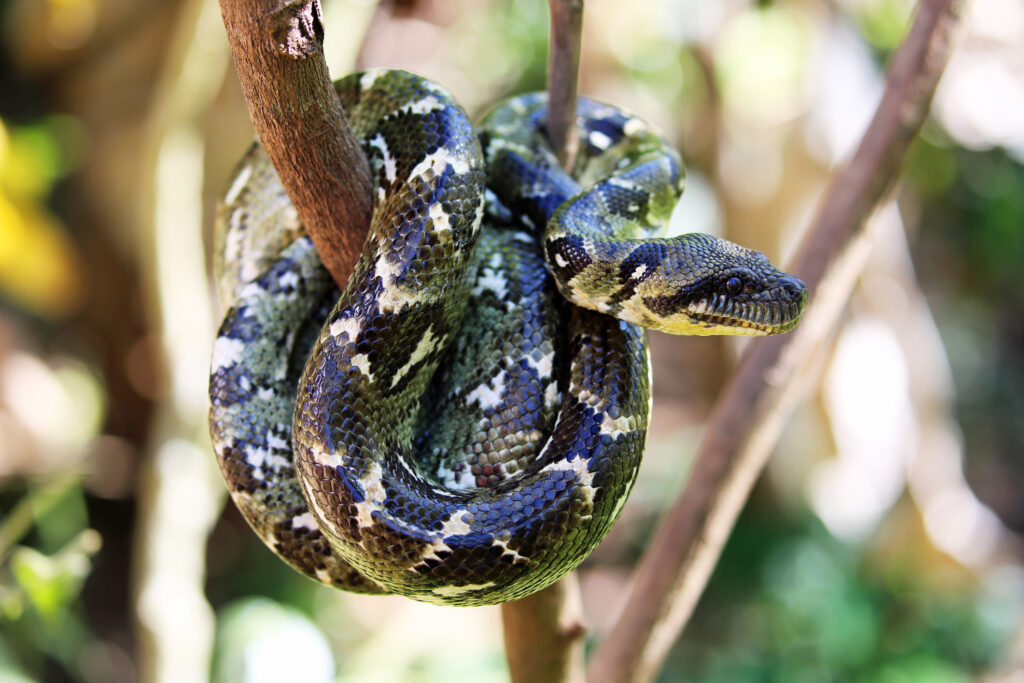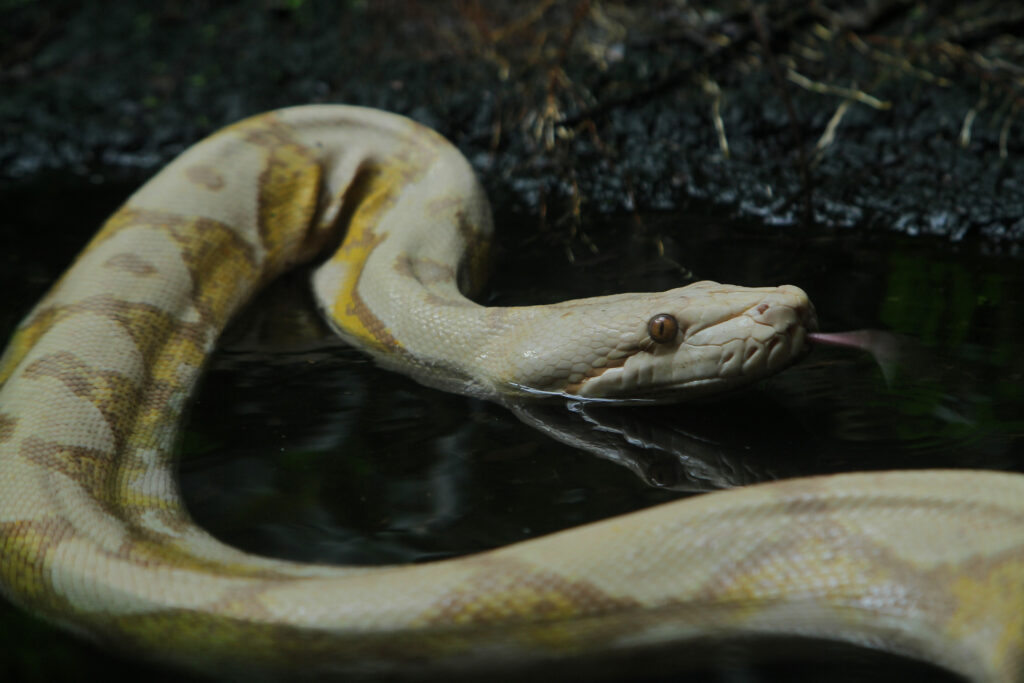Snakes are some of the most intriguing and misunderstood animals on Earth. From their silent, slithering movement to their extraordinary survival adaptations, these reptiles have fascinated humans for centuries. In this fact file, we’ll answer some of the most pondered questions about snakes, from what they eat and how they sense the world, to which species are the largest, smallest, and most venomous.
What are snakes?
Snakes are reptiles, belonging to the suborder Serpentes, and they’re found across most of the world. Like other reptiles, snakes are cold-blooded, which means they rely on external heat sources such as the sun to regulate their body temperature.
Snakes are also classed as vertebrates; they have a backbone made up of hundreds of flexible vertebrae. This skeletal structure, combined with powerful muscles, allows snakes to move efficiently despite lacking arms or legs.
What do snakes look like?
You’ll definitely be familiar with the tube-like bodies of snakes that are covered in scales, which not only protect their bodies but also help with movement and water retention. These scales can range in colour from muted browns and greens for camouflage, to vibrant reds, yellows, and blues designed to warn predators or attract mates.
The colours of snakes aren’t just for show; they serve vital purposes such as camouflage in their natural habitat, heat absorption in cooler regions, or deterrence against predators.
Unlike many animals, snakes lack eyelids and outer ears. Instead, they have a clear scale that covers their eyes and rely on vibration and special sensory adaptations to perceive the world around them.

12 facts about snakes you need to know
Snakes are fascinating, highly adaptable creatures with traits that help them thrive in almost every environment. Here are some of the most surprising facts about them:
There are over 3,000 species of snakes
Snakes can be found on almost every continent, with the exception of Antarctica. They’re also not found in Iceland, Ireland, Greenland, or New Zealand.
Around 600 species of snakes are venomous
It’s important to note that snakes are venomous, not poisonous. Venom must be injected (through a bite, sting, or fang), whereas poison is harmful when ingested or touched.
Examples of venomous snakes include:
- Saw-scaled viper (Echis carinatus) found in the Middle East, Central Asia.
- Inland taipan (Oxyuranus microlepidotus) found in Central east Australia.
- Black mamba (Dendroaspis polylepis) found in Sub-Saharan Africa.
- Russell’s viper (Daboia russelii) found on the Indian Subcontinent.
- Common krait (Bungarus caeruleus) found on the Indian Subcontinent.
Snakes shed their skin
Like other reptiles, snakes periodically shed their skin to grow and remove parasites. This process, known as ecdysis, happens several times a year depending on the snake’s age and environment.
Snakes are carnivores and can go months without food
Snakes eat a wide variety of prey, including small mammals, birds, rodents, fish, amphibians, insects, and eggs. Thanks to stretchy jaws, expandable bodies, and movable ribs, they can consume prey much larger than their head. Once fed, many snakes can go weeks or even months without another meal due to their slow metabolism.
Snakes live in all climates except extreme cold
Snakes thrive in deserts, grasslands, forests, and even underground burrows. Some, like sea snakes, are adapted to life in the ocean, only coming to the surface to breathe.
Some species of snakes are native to the UK
While the UK isn’t famous for snakes, there are three species that live here:
- The adder (Vipera berus) is the UK’s only venomous snake
- The smooth snake (Coronella austriaca) is a rare and secretive species, you’d be lucky (or unlucky) to spot.
- The grass snake (Natrix helvetica) is a reasonably common snake often spotted across England and Wales.
They are most commonly seen in the warmer months.
The longest snake is the reticulated python
The reticulated python (Malayopython reticulatus) can grow over 6.25m in length, with the largest on record reaching 10m back in 1912. These giant snakes are found across Southeast Asia.

The green anaconda is the heaviest snake in the world
The green anaconda (Eunectes murinus) can weigh up to 249kg and grow as long as 9 metres. They thrive in the swamps, rivers, and rainforests of South America, particularly in the Amazon Rainforest.
The Barbados threadsnake (Tetracheilostoma carlae) is the smallest snake in the world
Measuring no more than 10cm long, this tiny species primarily lives underground by burrowing through dirt. Many of the smallest snakes are blind, as eyesight isn’t necessary for their underground existence.
Some snakes lay eggs
Most snakes reproduce by laying eggs. For example, pythons may lay dozens of eggs at a time, often guarding them until they hatch. However, some snakes give birth to live young, such as boas and vipers, which are ovoviviparous, the eggs hatch inside the mother before birth.
In winter, snakes enter a hibernation-like state
In colder regions, snakes enter brumation, a state of dormancy similar to hibernation, to conserve energy. Not all snakes do this – tropical species remain active year-round, while those in temperate climates use this survival strategy to endure the cold.
Snakes have unique senses
Snakes “smell” using their forked tongues, which collect chemical particles from the air and deliver them to the Jacobson’s organ on the roof of the mouth.
Certain species, including pit vipers, pythons, and some boas, also have heat-sensing pits near their mouths. These allow them to detect the infrared radiation (heat) emitted by warm-blooded prey – even in total darkness.
See snakes at Blue Planet Aquarium
Want to see these amazing creatures up close? At Blue Planet Aquarium, you can meet a few incredible species of snakes:
Madagascar tree boa
Found in the Flooded Forest exhibit, this striking boa is known for its patterned scales and arboreal lifestyle. If you ever find yourself in the Madagascan rainforests, you might find a Madagascar tree boa looking down on you, waiting for its next meal to walk past.
False water cobra
Part of the Venom exhibit, this South American species flattens its neck like a cobra when threatened, although it’s not a true cobra; however, it is venomous, but not usually dangerous to humans.
Mangrove snake
This gorgeous black-and-yellow species, also featured in the Venom exhibit, is known for its nocturnal hunting habits, seeking out prey like small mammals, birds (including their eggs), lizards, and frogs.
Rhinoceros rat snake
With its unusual “horn-like” projection on its nose, this beautiful green snake is sure to catch your eye at the Venom exhibit. Despite quite a fearsome name, these snakes are quite small and cute, if we say so ourselves.
Green cat eye snake
Sleek and agile, this snake rounds out the Venom exhibit with its sharp gaze and impressive climbing skills. It’s usually found in South and East Asia, in places like India and China.
Snakes are truly remarkable creatures, from the tiniest threadsnake to the giant anaconda. With their unique senses, diverse adaptations, and wide global distribution, they remain some of the most fascinating reptiles on Earth.
To see snakes in action, book your tickets to Blue Planet Aquarium, and while you’re here, be sure to check out our other animal fact-files to find out more incredible facts about the other animals that we house at the aquarium.
